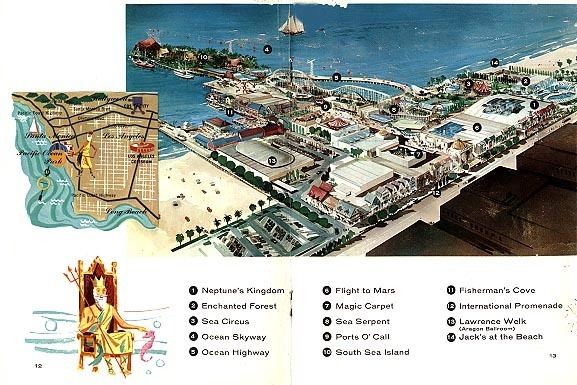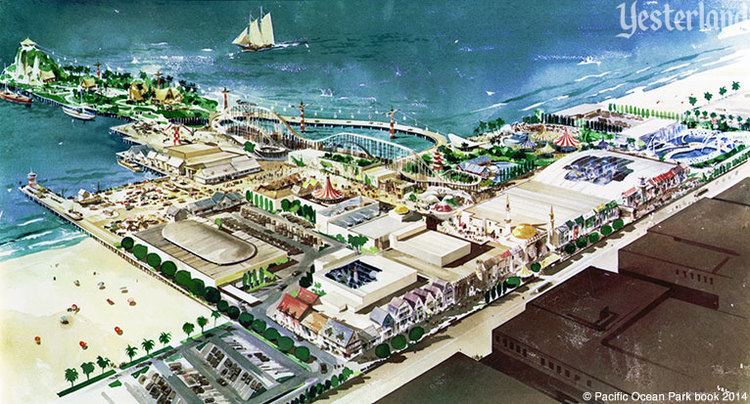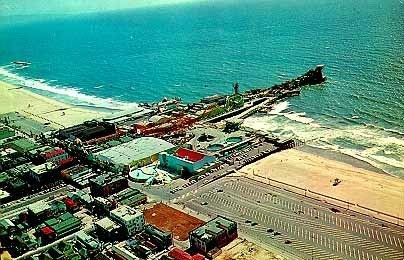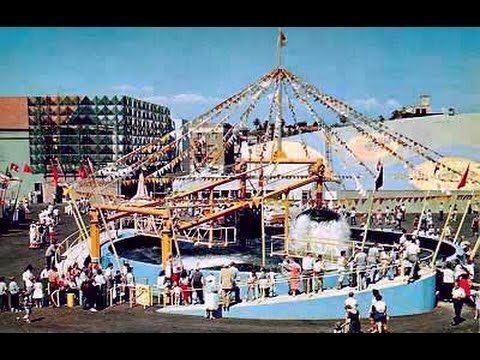Closed 6 October 1967 | Opened 26 July 1958 | |
 | ||
Similar The Pike, Marineland of the Pacific, Japanese Village and Deer Park, Santa Monica Pier, Palisades Park | ||
Pacific ocean park
Pacific Ocean Park was a twenty-eight acre (110,000 m²), nautical-themed amusement park built on a pier at Pier Avenue in the Ocean Park section of Santa Monica, California, which was intended to compete with Disneyland. "And Disneyland and POP is worth a trip to L.A." is a line from the Beach Boys' song "Amusement Parks U.S.A." from their 1965 album Summer Days (And Summer Nights!!). After it closed and fell into disrepair, the park and pier anchored the Dogtown area of Santa Monica.
Contents
- Pacific ocean park
- Baby boomers tribute pacific ocean park in color 1958 67
- The Beginning
- Attractions
- The End
- In Popular Culture
- References

Baby boomers tribute pacific ocean park in color 1958 67
The Beginning

"POP" (pronounced "pee-oh-pee"), as it was soon nicknamed, was a joint venture between CBS and Santa Anita Park. It opened on Saturday, July 28, 1958 with an attendance of 20,000. The next day, the park drew 37,262 which outperformed Disneyland's attendance that day. Admission was ninety cents for adults which included access to the park and certain exhibits. The term "POP" was also used as a clever acronym for "Pay One Price", though other rides and attractions were on a pay-as-you-go basis.

Like Disneyland, Pacific Ocean Park found corporate sponsors to share the expense of some exhibits. Six of the pier's original attractions were incorporated into the new park: The Sea Serpent roller coaster, the antique Looff carousel, the Toonerville Fun House, the Glass House, twin diving bells and more.
Attractions
Among a standard complement of carnival-style attractions and rides were the following:



By January 5, 1959, Pacific Ocean Park had attracted 1,190,000 visitors. Although plans were made to add four new attractions, only two were completed at a cost of $2,000,000. They were:
The End
In 1965, Santa Monica began the Ocean Park urban renewal project. Buildings in the surrounding area were demolished and streets leading to the park were closed. As a result, visitors found it hard to reach the park and attendance plummeted to 621,000 in 1965 and 398,700 in 1966.
At the end of the 1967 tourist season, the park's creditors and the City of Santa Monica filed suit to take control of the property because of back taxes and back rent owed by the park's new owner since 1965. Pacific Ocean Park closed on October 6, 1967. The park's assets were auctioned off June 28 through June 30, 1968. The proceeds from the sale of thirty-six rides and sixteen games were used to pay off creditors. The ruins of the pier became a favorite surfing area and hangout of the Z-Boys of Dogtown fame. The park's dilapidated buildings and pier structure remained until several suspicious fires occurred and it was finally demolished in the winter of 1974-75.
Other than a few underwater pilings and signs warning of them, nothing remains of Pacific Ocean Park today. A few miles north, the original Santa Monica Pier features a newer amusement park, similarly called Pacific Park. Today, the rides and attractions of the Santa Monica Pier include the Carousel that is featured in the 1973 Academy Award -winning film The Sting.
In Popular Culture
The climactic scene in the final episode of the television series The Fugitive ("The Judgment, Part 2)" was shot at Pacific Ocean Park. Filmed on location just prior the park's closure in the fall of 1967, the park's "Mahi, Mahi" ride tower was the setting for the dramatic face off between Dr. Richard Kimble (David Janssen) and the fictional one-armed man. The episode of the Twilight Zone series titled "In Praise of Pip," starring Jack Klugman and Billy Mumy, was also filmed there. An episode of The Man From U.N.C.L.E. was filmed in the park. A short color film shot at the park, highlighting various summertime attractions, was seen in the opening segment of The Dinah Shore Chevy Show on NBC-TV, April 24, 1960. A second film, made on the park's Rollercoaster for a musical number, was superimposed behind an in studio Miss Shore and an all male vocal group simulating a park ride. The song performed was the Leo Robin-Ralph Rainger composition, "Having Myself A Time," popularized by Billie Holiday. The park was the setting of an episode of the television series Route 66 (Season 2, Episode 29 "Between Hello and Goodbye") which aired May 11, 1962. Martin Milner's character Tod is shown working at King Neptune's Courtyard, and guest star Susan Oliver is depicted riding the Ocean Skyway.
Part of the 1965 Connie Stevens/Dean Jones movie, "Two on a Guillotine" was filmed at the park, including an extended scene of them riding on the Ocean Skyway.
Part of the 1966 Herman's Hermits movie Hold On! was filmed at the park.
An episode of The Invaders, entitled "The Pit," televised on ABC in January, 1967, has scenes shot at Pacific Ocean Park after the park had closed.
The sequence for the song "Who Will Buy?" in the 1967 Nancy Sinatra NBC television special Movin' With Nancy was filmed at the park just a few days after the park's permanent closure in October 1967.
The Mod Squad episode "Bad Man on Campus" started and ended at the park in 1968. Also in the programmes first episode, "Teeth of the Barracuda," the Panther Pit exterior scenes were filmed on and around the park.
Get Smart episode "The Wax Max," televised February 24, 1968 was filmed in the park.
Portions of an episode for The Name of the Game (TV series), entitled "Cynthia Is Alive and Living in Avalon" (season 3, episode 3), were filmed at the park, in-between the on-going processes of demolition. The plot called for the location to serve as a somewhat remote impromptu hideout, sought by a young Social Activist woman, who was on-the-run from authorities. The episode starred Robert Culp and Barbara Feldon, and was originally aired on Friday, October 2nd 1970 on NBC.
The band Daniel Amos mentions the park in the song "The Organ Bar" on the 1995 album Songs of the Heart.
